2. Addis Ababa University, P.O. Box: 1176, Addis Ababa, Ethiopia
Ethiopia possesses a large and diverse resource of plants and wildlife due to the extreme variation in climate and terrain. FAO (1996) stated that Ethiopia is one of the African countries known for high endemism of wild plant and animal species. In addition, because of her long history of agriculture and diversity of environments, Ethiopia is one of 12 Vavilov centers of crop genetic diversity (Woldu 2008; KiKitessa et al. 2008). Ethiopia has over 300 tree species, which are used for construction and industrial purposes.
Ethiopian forests and woodlands are repositories and gene banks for several domesticated and/or important wild plants and wild relatives of domesticated plants. For example, coffee (Cof fea arabica L.) is found in the wild in the moist evergreen montane forests of the south, west, and southwest of the country. Forests are important not only for the products that can be harvested from them but also for preventing erosion and for affecting the climate in a positive way (NBSAP 2005).
Many scholars have studied and described Ethiopian vegetation. Based on their results, the vegetation types of Ethiopia have been grouped into eight general categories. These are Desert and Semi-desert Scrubland, Acacia-Commiphora Woodland, Moist Evergreen Montane Forest, Lowland Semi-evergreen Forest, Combertum-Terminalia Woodland, Dry Evergreen Montane Forest, Afroalpine, and Sub-Afroalpine Vegetation, and Riparian and Wetland Vegetation (Kelbessa et al. 1992; Demissew et al. 1996; Friis et al. 2001; Demissew et al. 2004; Demissew and Friis 2009; Zerihun et al. 1989).
Afromontane forests in Ethiopia are generally cooler and more humid than the surrounding lowland although the classification of forests as "moist" or "dry" and the criteria followed to define these limits are loose. Logan (1946) used altitudinal variations to distinguish between what he called 'climatic moist woodland' and 'climatic dry woodland' on the Ethiopian plateau (Bekele 1994). Characteristic species in Afromontane area of Ethiopia include Podocarpus falcatus, Prunus africana, Hagenia abys sinica, Juniperus procera, and Olea sp.
The moist Evergreen Montane Forest comprises the humid forest in the southeastern plateau, Harenna Forest, (Lissanework et al. 1989) and Mana Angetu Forest (Lulekal et al. 2008) and high forests of the country mainly the southwest forests. Several researchers have studied the composition and structure of this forest vegetation type in southern, southwest and western part of the country and described them on floristic basis (Lisanework et al. 1989; Woldu et al. 2008; Yeshitela and Bekele 2002; Kelbessa and soromessa 2008). The Moist Evergreen Montane Forest of west and southwest Ethiopia occurs between 1, 500-2, 500 m a.s.l. in Wollega, Illubabor and Kefa. The average annual temperature and rainfall of this vegetation type is 18-20℃, and 1, 500 and 2, 000 mm, respectively. The maximum rainfall is from April to October (Friis et al. 1982; Friis 1992)
Moist evergreen montane forest ecosystem is the most diverse ecosystem in composition, structure and habitat types (NBSAP 2005). The common species in this forest include Pouteria altis sima, Pouteria adolfi-friederici, Trilepsium madagascariense, Morus mesozygia, Mimusops kummel, Podocarpus falcatus, Coffea arabica, Galiniera saxifraga, Syzygium guineense ssp. afromontanum, Apodytes dimidiata, Prunus africana, Albizia gummifera, Albizia schimperiana, Croton macrostachyus, Cas sipourea malosana, Ekebergia capensis, Euphorbia ampliphylla, Ficus sur, Maesa lanceolata, Teclea nobilis and Bersama abys sinica (EFAP 1994; FAO 1996; NBSAP 2005; Senbeta and Denich 2006; Kelbessa and Soromessa et al. 2008).
About 35%-40% of the land area of Ethiopia was covered by forest vegetation in the 1990s (EFAP 1994). Since then, forests have been destroyed at an alarming rate and the area covered by forests by 1998 was only 2.4 percent (EPA 1998). Factors such as rising demand for timber products, conversion of forest land to agricultural land, and expanding population pressure are responsible for the decline in the forest cover of the country (EPA 1998; USAID 2008).
Even though Ethiopia is rich in biodiversity with high endemism and most of her forests have provided socio-economic benefits and ecological functions for long periods of time, many species are now being threatened or are endangered or locally extinct. This is due to habitat destruction and fragmentation, and over-exploitation of wildlife and habitats (Teketay 2001). Understanding natural regeneration of plant communities requires information on soil seed banks and/or seedling banks, and quantity and quality of seed rain and durability of seeds in the soil (Teketay 2005).
Komto Forest was proposed as a Forest reserve area in 1976 and demarcated as a state forest in 1990 as one of the 58 National Forest Priority areas (NFPA), (EFAP 1994). Though the Forest has been under protection since its demarcation, it has been continuously exploited by surrounding people for agricultural land expansion, timber harvesting, firewood collection and charcoal production, woodcutting for construction and other purposes. Little is known about the forest, as there is no floristic and structural study was made before. Thus, the present study has the following objectives: (1) to analyze the structure of the forest, (2) to determine the regeneration status of some woody species, and (3) to assess the status of the vegetation and to make some recommendations on the management and conservation of the forest.
Materials and methods Study areaThe forest covers an area of about 500 ha at latitudes 9°05.10′-9°06.35′ N and longitude 036°36.47′-036°38.10′ E (Fig. 1). Elevations range from 2, 100 to 2, 482 m a.s.l. on Komto Mountain
The rainfall and temperature data for this study were collected from the nearest Meteorological Station, Nekemte, which is about 12 km away from the capital of Wayu Tuka District. Data were collected from 1998-2007 by National Meteorological Service Agency. Climate diagram was computed by using R for window version 2.10.1 statistical package (R-Development Core Team 2007). The area falls within the southwestern and western unimodal rainfall regions of Ethiopia. Generally, the study area is humid and moderately hot. The mean annual temperature is about 18.8℃, and the mean minimum and maximum temperatures are 12.2℃ and 27.9℃, respectively. The hottest months are from February to October with maximum temperature record in February and May (27.9℃) and the coldest months are November to January with minimum temperature of 12.2℃ in December and January (Fig. 2). The mean annual rainfall of the study area is 2, 067 mm. The rainfall pattern is unimodal, with little or no rainfall in January and February, gradually increasing to a peak between May and October, and decreasing in November and December (Fig. 2).
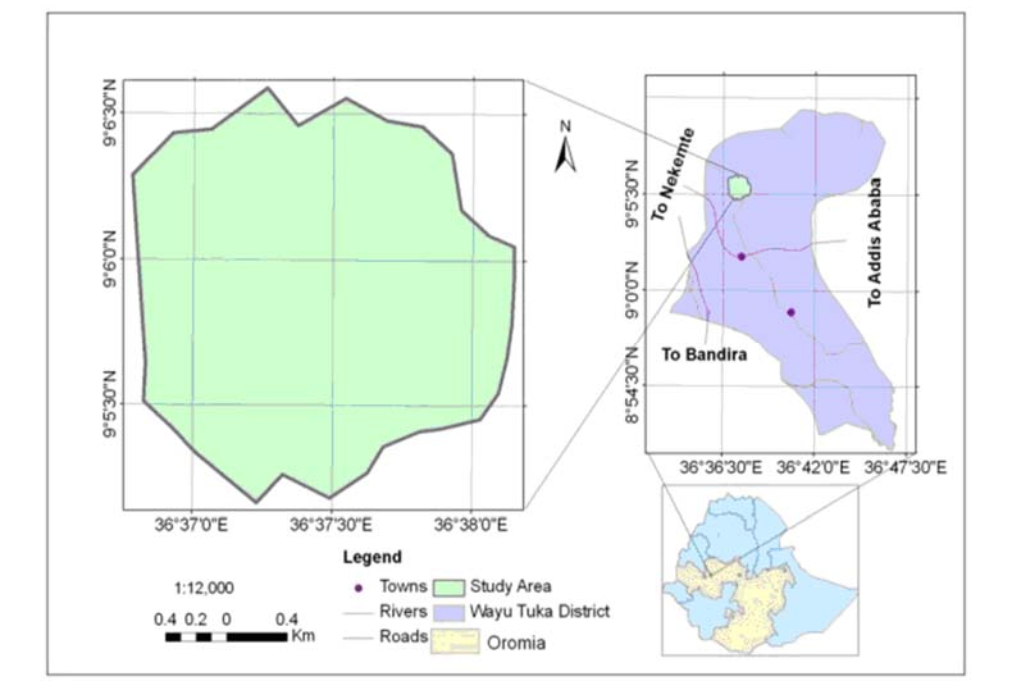
|
Fig. 1 Location map of the study forest |
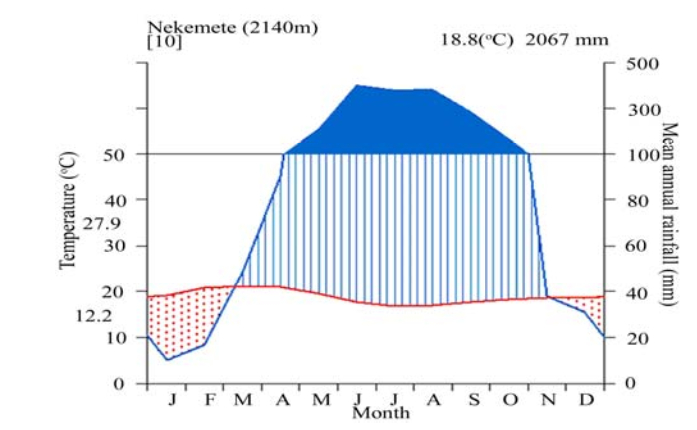
|
Fig. 2 Climatic diagram of Nekemte Town (1998−2007) |
Vegetation of the study area (eastern highlands of Wollega) is broad-leaved and evergreen moist forests with important tree species including Outeria adolfi-friederici, Syzygium guineense ssp. afromontanum, Apodytes dimidiata, Prunus africana, Al bizia gummifera, Albizia schimperiana, Croton macrostachyus, Cassipourea malosana, Ekebergia capensis, Euphorbia am pliphylla, Ficus sur, Maesa lanceolata, Teclea nobilis, and Ber sama abyssinica (Teketay 2005).
Degradation of the high forest led to formation of bushland and farmland (personal observation and communication with inhabitants of the area). Komto Forest hosts wild animals including spotted hyena, abyssinian black and white colobus monkey, common jackal, blue monkey, bushbuck, common duiker, aardvark, olive baboon, hare, vervet monkey, and crested porcupine. The wildlife, similar to the forest, is severely threatened by deforestation and habitat fragmentation due to human encroachment.
Reconnaissance survey, sampling design and data collectionSystematic sampling methods followed Kent and Coker (1992) and Muller-Dombois and Ellenberg (1974). Sampling quadrats were arranged along transects in eight (E, NE, N, NW, W, SW, S, SE) directions from the peak of Mount Komto to its base and onto the surrounding plain. Quadrats covered variations in aspect and slope and included one quadrat at the top of the mountain. Along the eight transects we set 20 m × 20 m (400 m2) sampling quadrats at intervals of 200 m. The numbers of quadrats/transect varied depending on the length of each transect. A total of 53 quadrats were sampled. Five 5 m × 5 m sub plots, one at each corner and one at the center of the main quadrat were set to sample shrubs. We sampled from October 15 to November 25, 2009. A complete list of trees, shrubs, and lianas was made from the systematically selected quadrats along each transect. Specimens of all woody plant taxa were collected, pressed, dried and brought to the National Herbarium (ETH), Addis Ababa University for identification and storage. Nomenclature followed Flora of Ethiopia and Eritrea (FEE).
In each plot, diameter and height were recorded for all woody plants. Diameter was measured for all individual trees and shrubs having DBH (Diameter at Breast Height) greater than 2.5 cm. If the tree branched at breast height or below, the diameter was measured separately for the branches and averaged. Trees and shrubs with DBH less than 2.5 cm were counted. Height was measured for individual trees and shrubs with DBH greater than 2.5 cm using Suunto Height Meter and calibrated stick. Where topographic features made it difficult to measure trees and shrubs, height was estimated visually. We calculated seedling and sapling densities and regeneration of selected species within the same quadrats. We partitioned the major quadrats (400 m2) into four, each 100 m2 (10 m × 10 m), to ease the counting of seedlings. In each 100 m2 quadrat, we counted all seedlings less than 1 m in height. Individuals attaining 1 m and above with DBH less than 2.5 cm were considered as saplings and counted. Environmental variables such as altitude and geographical coordinates were also measured for each plot using Garmin 72 Geographical Position System (Kent et al. 1992).
Structural data analysisThe importance value index compares the ecological significance of species. Species with the greatest importance value are dominant in the forest. Importance value indices (IVI) were computed for dominant woody species based on their relative density (RD), relative dominance (RDO) and relative frequency (RF) as follows (Kent et al. 1992):
| $ {I_{{\rm{VI}}}} = {R_{\rm{D}}} + {R_{{\rm{DO}}}} + {R_{\rm{F}}} $ | (1) |
where, RD is the number of all individuals of a species/the total number of all individuals (DBH > 2.5 cm) × 100; RF is the number of plots where a species occurs/ the total occurrence of all species in all of the plots × 100. RDO is Dominance of a species/Dominance of all species × 100 (DBH > 2.5 cm) and Dominance is mean basal area/tree × the number of trees of a species.
Basal area provides a better measure of the relative importance of the species than does a stem count (Cain et al. 1959; Tamirat 1994). Basal area (BA) was calculated using DBH as follows:
| $ {B_{\rm{A}}}{\rm{ = }}\pi {d^2}/4 $ | (2) |
where, π= 3.14; d is DBH (m).
The structure of the vegetation was described using frequency distributions of DBH, height and IVI. Tree or shrub density and basal area values were computed per hectare. The vertical structure of the woody species occurring in the Komto Forest was analyzed using the IUFRO classification scheme. This scheme categorizes a vertical structure of vegetation into upper, middle and lower storey. The population structures of some selected species were also analyzed for the interpretation of the pattern of population dynamics in the forest.
ResultsWe recorded 103 woody plant species of 87 genera and 45 families in Komto Forest (Appendix Ⅰ). Of these, 42 species are trees, 43 species are shrubs, 17 species are lianas, and 1 species is a woody hemi-parasite. Fabaceae and Malvaceae were the most dominant families, contributing 12 species and 8 species to the total, respectively. These families were followed by Celestraceae with 6 and Euphorbiaceae with 5 species. The remaining 41 families contributed four or fewer species.
|
|
Appendix1 List of woody species collected from Komto Forest (2009) |
Density of trees and shrubs with DBH greater than 2.5 cm was 952.83 individuals·ha-1. Density of trees and shrubs with DBH 10-20 cm was 330 individuals·ha-1. Density of trees and shrubs with DBH greater than 20 cm was 215 individuals·ha-1 (Table 1). The ratio described as a/b, is taken as the measure of size class distribution. Accordingly, the ratio of individuals with DBH 10-20 cm (a) to DBH > 20 cm (b) was 1.53.
|
|
Table 1 Density of trees and shrubs by DBH class |
Comparison of tree and shrub densities with DBH 10-20 cm (a), DBH > 20 cm (b) and the ratio (a/b) for Komto Forest with ten other forests in Ethiopia is given in Table 2. The a/b ratio at Komto Forest was lower than at Alata-Bolale, Menagesha Suba, Chilimo, and Masha Anderacha, but higher than at Dodola Forest (Table 2).
|
|
Table 2 Comparisons of tree and shrub densities with DBH 10-20 cm (a) and tree density with DBH > 20 cm (b) from Komto Forest with 10 other forests in Ethiopia |
The frequency distribution of height classes of trees and shrubs in Komto Forest is given in Fig. 3. More than 65% of trees and shrubs were less than 9 m tall (Height classes 1 and 2). Only a small proportion, about 24%, reached a height of 15 m and above indicating dominance by shorter plants.
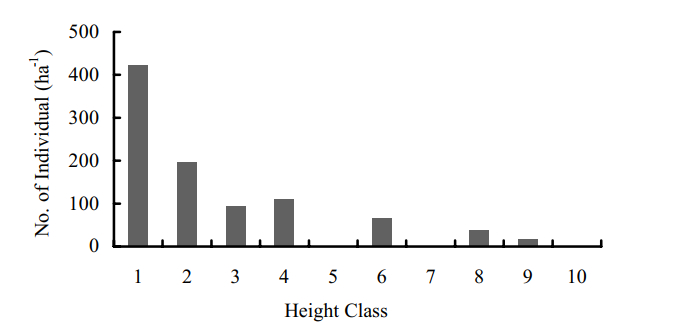
|
Fig. 3 Height classes versus relative density ha-1 in Komto Forest (Tree species are classified according to different height classes, such as, 1 stands for 2.6−6.0 m, 2 stands for 6.1−9.0 m, 3 stands for 9.1−12.0 m, 4 stands for 12.1−15.0 m, 5 stands for 15.1−18.0 m, 6 stands for 18.1−21.0 m, 7 stands for 21.1−24.0 m, 8 stands for 24.1−27.0 m, 9 stands for 27.1−30.0 m and 10 stands for > 30.0m). |
DBH distribution of the woody species is given in Fig. 4. As DBH increased, the number of individuals decrease beginning from 548.58 stems·ha-1 in the first class down to 12.73 stems·ha-1 in the last DBH class. The distribution curve was a regular inverted J-shaped distribution of individuals across the DBH classes.
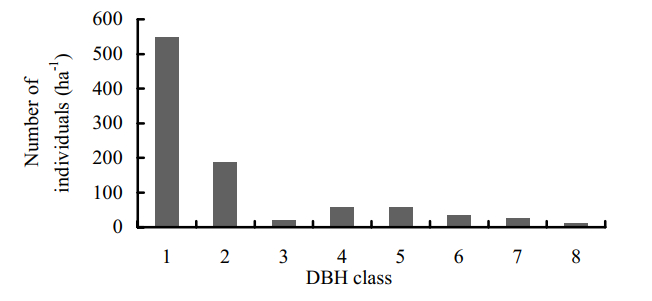
|
Fig. 4 DBH class versus the number of individuals per hectare. (Tree species are classified according to different DBH classes, such as, 1 stands for 2.6−12.0 cm of DBH, 2 stands for 12.1−22.0 cm, 3 stands for 22.1−32.0 cm, 4 stands for 32.1−42.0 cm, 5 stands for 42.1−52.0 cm, 6 stands for 52.1−62.0 cm, 7 stands for 62.1−72.0 cm and 8 stands for ≥72.0 cm). |
Species with the largest contribution in basal area can be considered the most important woody species in the forest. Total basal area for Komto Forest was 50.72 m2·ha-1. The contribution of each DBH class to the total basal area is presented in Table 3 and Fig. 5.
|
|
Table 3 Contribution of different DBH classes to the total density and basal area per hectare in Komto Forest |
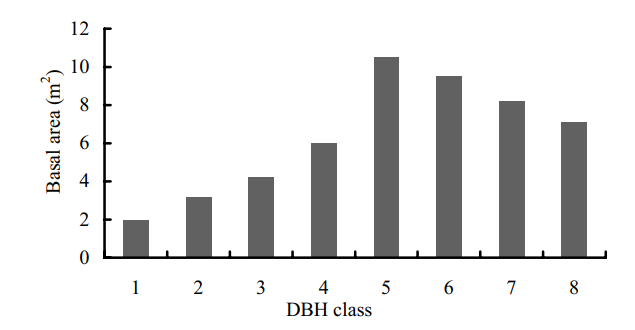
|
Fig. 5 Basal area distribution over DBH classes of Komto Forest |
Table 3 shows that 57% of all individuals had DBH less than 12 cm (DBH class 1). The percentage contribution of this class to the total basal area, however, was only 3.87%. Conversely, individuals in the DBH classes greater than 42 cm had a density of about 14% of the total, but they accounted for about 69.64% of the total basal area of the Forest.
The basal area of Komto Forest was greater than that of Menagesha Suba, Chilimo, and Denkoro Forests (Abate et al. 2006), and comparable with that at Jibat (Bekele 1993) and Dindin Forests (Shibru and Balcha 2004). Komto had less basal area than did Alata-Bolale Forest (Woldeyohannes 2008), Gendo Forest, Masha-Anderacha Forest (Yeshitela and Bekele 2003) and Wof-Washa Forest (Bekele 1993), (Fig. 6).
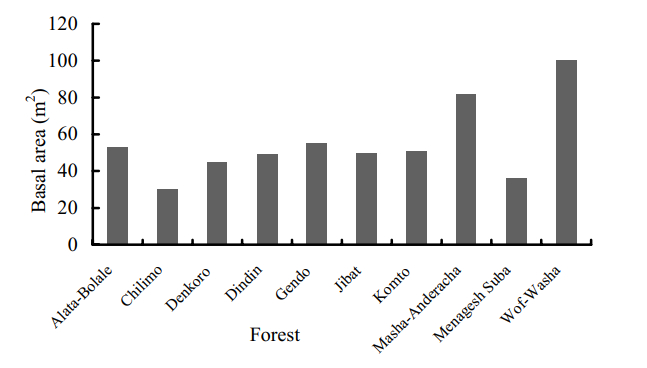
|
Fig. 6 Basal area (m2) of different forests in Ethiopia |
The IUFRO classification scheme classifies the storey into upper, where the tree height is greater than 2/3 of the top height; middle, where the tree height is in between 1/3 and 2/3 of the top height and the lower storey where the tree height is less than 1/3 of the top height. The top height for trees in Komto Forest was 40 m. The tree species that occupied the upper storey in Komto Forest included Croton macrostachyus, Prunus africana, Pouteria adolfi-friederici, Ficus sur, Schefflera abyssinica, Euphorbia ampliphylla. In addition, only few individuals attained the upper storey as the ratio of individuals to species is lower (Fig. 7 & Table 4).
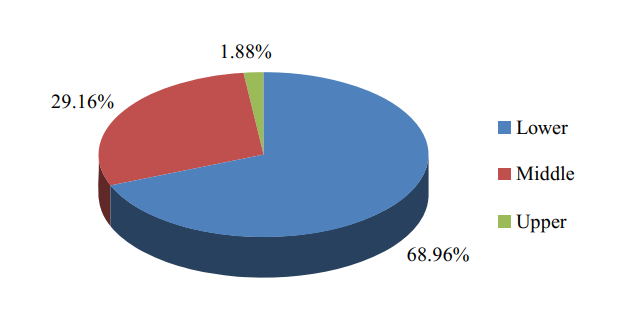
|
Fig. 7 Percentage density of trees in lower, middle and upper storey |
|
|
Table 4 Density, species number and individuals to species ratios by storey |
The middle layer of Komto Forest was occupied by species including Syzygium guieneense ssp. afromontanum, Allophylus abyssinicus, Albizia gummifera, Albizia schimperiana, Teclea nobilis, Vepris dainellii, Olea capensis ssp. macrocarpa, Can thium oligocarpum, Millettia ferruginea, Olea welwitschii. The lower storey was largely dominated by shrubs and small trees such as Rytigynia neglecta, Erytrococca trichogyne, Clausena anisata, Chionanthus mildbraedii, Dombeya torrida, Flacourtia indica, Psychotria orophila.
The highest proportion of species was concentrated in the lower storey (94.44%) followed by the middle (69.44%) and upper storey (36.11%), (Table 4). A similar result was observed by Kelbessa and Soromessa (2008) in Bonga Forest.
Importance value indexSpecies with lower IVI values need high conservation efforts while those with higher IVI values need monitoring management. IVIs for 36 species are listed in Table 5. Syzygium guineense ssp. afromontanum, Croton macrostachyus, Ficus sur, Allophylus abyssinicus, Apodites dimidiata, Rytigynia neglecta and Pouteria adolfi-friederici had the highest IVI values (Table 5). This is because of their low demand by the local people for timber and other construction material. These seven species contributed about 50% of the total importance values whereas the remaining woody species (80.56%) had combined IVI values of about 50%. In addition, Myrtaceae, a family with single species Syzygium guineense ssp. afromontanum, was the most important family in the Forest (Table 5).
|
|
Table 5 Importance Value Index (IVI) of the dominant tree species of Komto forest |
Rytigynia neglecta, Syzygium guineense ssp. afromontanum, Pouteria adolfi-friederici and Croton macrostachyus were the four most abundant species, accounting for 29.7% of total density (Table 5). Syzygium guineense ssp. afromontanum, Croton macrostachyus, Allophylus abyssinicus and Rytigynia neglecta were recorded at highest frequently (Table 5). Most species were in the lower IVI classes (Fig. 8).
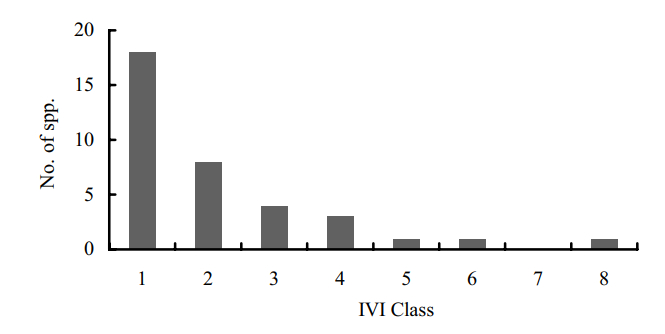
|
Fig. 8 Number of species by IVI class in Komto Forest (IVI classes 1 stands for 0−5, 2 stands for 5.1−10.0, 3 stands for 10.1−15.0, 4 stands for 15.1−20.0, 5 stands for 20.1−25.0, 6 stands for 25.1−30.0, 7 stands for 30.1−35.0 and 8 stands for 35.1 and above) |
The pattern of diameter class distribution indicates the general trend of population dynamics and recruitment processes of a species. Analysis of the population structure of 36 tree species revealed four general patterns (Fig. 9A-D). The total seedling, sapling, and mature woody tree densities of 36 selected tree and shrub species were about 1888, 897, and 953 individuals per hectare respectively (Table 6).
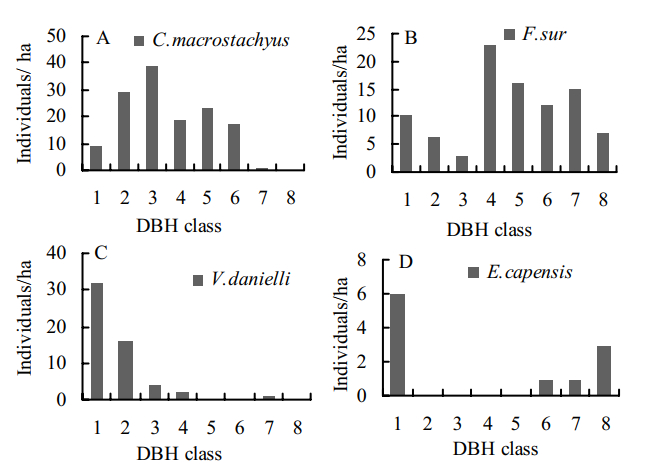
|
Fig. 9 Population structure of selected tree species (Tree species are classified according to different DBH classes, such as, 1 stands for 2.6−12.0 cm of DBH, 2 stands for 12.1−22.0 cm of DBH, 3 stands for 22.1−32.0 cm of DBH, 4 stands for 32.1−42.0 cm of DBH, 5 stands for 42.1−52.0 cm of DBH, 6 stands for 52.1−62.0 cm of DBH, 7 stands for 62.1−72.0 cm of DBH and 8 stands for≥72.0 cm of DBH). |
|
|
Table 6 Selected tree species with their seedling, sapling and mature tree density per hectare |
The composition, distribution and density of seedlings (SE) and saplings (SA) are indicators of the future regeneration status of any forest. The distribution of seedlings, saplings and mature trees/shrubs shows three distinct patterns (Fig. 10 a-j). The first group includes species represented by all three stages, the second group includes seedling and mature trees/shrubs but no saplings (Fig. 10 i & j). The third group of species includes only mature trees/shrubs (Fig. 10 e & f).
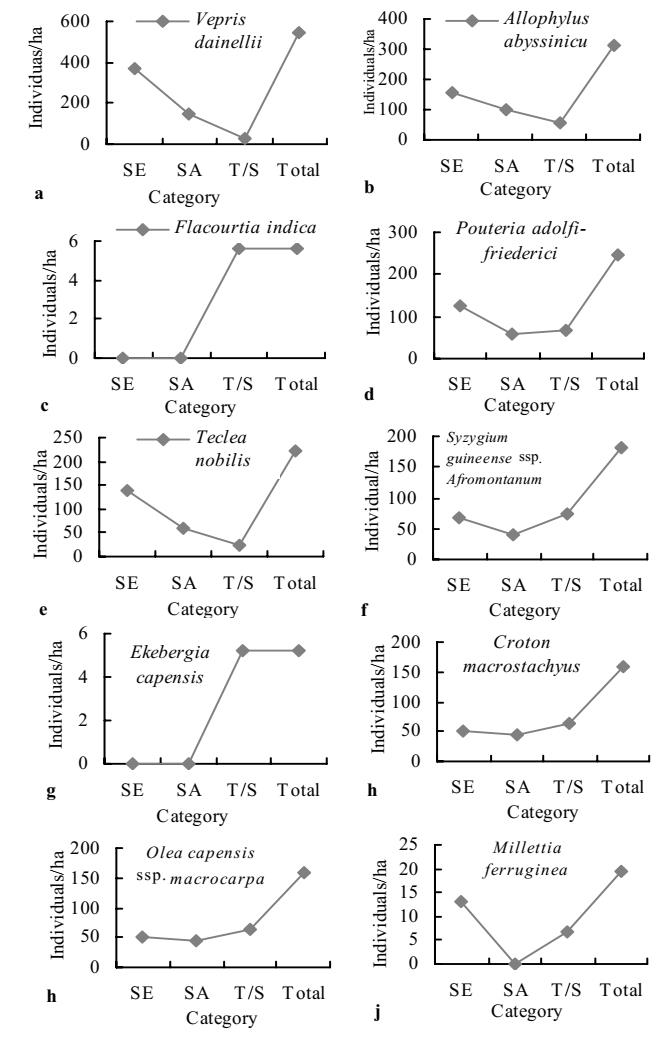
|
Fig. 10 (a-j). Seedlings, saplings and tree/shrub distribution of some selected species occurring in Komto Forest |
Seven species (19.44%) were not represented by both seedlings and saplings (Table 7), and only a few mature individuals were recorded for these species (Table 6). On the other hand, 5 species (13.88%) of the total were not represented by saplings (Table 6).
|
|
Table 7 Species conservation priority classes |
Based on these results, tree species were grouped into 3 priority classes for conservation. These are class 1 with no seedlings or saplings, Class 2 with seedlings but no saplings, and Class 3 with both seedlings and saplings ≥ 1 individual·ha-1 (Table 7).
Discussion Structural description in Komto ForestResults of the structural analysis of the natural vegetation of Komto Forest indicated that the proportion of medium-sized plants (DBH between 10 and 20 cm) was greater than for large plants (DBH > 20 cm) but the medium: large ratio was lower than for other forests (Alata-Bolale, Menagesha Suba, Chilimo and Masha Anderacha) but larger than Dodola Forest (Table 2). The proportion of small plants (DBH < 10 cm) was much greater (42.82%) although the above ratio is lower (Table 1), indicating that Komto Forest is in a stage of secondary regeneration.
Size class distributionDistribution of individuals in different height and DBH classes indicated an inverted J-shaped curve with most individuals in lower size classes (Fig 3, 4). This could be attributed to a high rate of regeneration but poor recruitment. Senbeta and Teketay (2003) also concluded that the dominance of shrubs and small trees in a forest suggests that bigger tree species are selectively removed. The frequency distribution of individuals in the different size classes in Komto Forest, however, was not uniform. The number was lower at DBH class 3 (Fig. 4). This might be due to selective cutting of individuals at this DBH.
The total basal area calculated for Komto Forest was 50.72 m2·ha-1, of which more than 21.47% (10.89 m2·ha-1) was contributed by Syzygium guineense ssp. afromontanum (Table 5). The predominance of this species in the Forest was probably because of the low market demand of its timber. Syzygium guineense ssp. afromontanum was also the dominant species in the Belete forest for a similar reason (Kitessa et al. 2008). Few large plants contributed a disproportionally large share of the total basal area (Table 3). Similar results were observed in the contribution of the different DBH classes to the basal area in other forests in Ethiopia as in Masha Anderacha Forest (Yeshitela and Bekele. 2003), Dodola Forest (Hundera et al. 2007), and Belete Forest (Kitessa et al. 2008).
Dominant species of Komto ForestDominant species for Komto Forest were identified based on their rank in IVI value (Table 5). Species with IVI value above 5.00 are referred to as dominant because of their abundance and large basal area. Accordingly, Syzygium guineense ssp. afromon tanum, Croton macrostachyus, Ficus sur, Allophylus abyssinicus, Apodytes dimidiata, Rytigynia neglecta, Pouteria adolfi-friederici, Prunus africana, Bersama abyssinica, Erytro cocca trychogyne, Albizia schimperiana, Vepris dainellii, Maesa lanceolata, Teclea nobilis, Clausena anisata, Albizia gummifera, Euphorbia ampliphylla and Pittosporum viridiflorum were identified as dominant species.
Population structureAnalysis of the population of 36 forest tree species revealed four general patterns (Fig. 9). The first pattern was a bell-shaped distribution formed by species with high numbers of individuals in the middle DBH classes (Fig. 9A). Species such as Croton mac rostachyus and Syzygium guineense ssp. afromontanum were characterized by this distribution pattern. This pattern indicates poor reproduction and recruitment, which may be associated with intense competition from surrounding trees. Senbeta et al. (2007) and Woldeyohannes (2008) reported similar reasons for a bell-shaped population structure.
The second pattern was formed by species with positively skewed distributions (inverted J-curve). These species had the highest density in lower DBH classes with gradual declines in density towards the bigger classes, suggesting good reproduction and healthy regeneration potential (Fig. 9B). Vepris dainellii, Teclea nobilis, Canthium oligocarpum, Bersama abyssinica, Cassipourea malosana, Maesa lanceolata, and Apodites di midiata had inverted J-curve population structure.
The third pattern (Fig. 9C) was formed by species having irregular distributions over diameter classes. Some diameter classes (DBH classes 2, 3 and 8) were poorly represented indicating selective removal of these classes while other diameter classes (DBH classes 4, 5 and 7) were well represented. The following species had this type of population pattern: Albizia schimperiana, Albizia gummifera, Allophylus abyssinicus, Eu phorbia ampliphylla, Ficus sur, and Macaranga capensis.
The fourth pattern was a U-shaped curve (Fig. 9D) formed by species with few or no individuals in the middle DBH classes and represented only by the lower and higher DBH classes. Species with this type of population structure were Prunus africana, Pouteria adolfi-friederici and Ekebergia capensis. The intermediate diameter classes might have been poorly represented due to selective removal of medium sized plants. For example, many stumps of Pouteria adolfi-friederici, a very important timber tree species in the area, were observed, suggesting a further risk of removal of the remaining individuals.
Generally, an inverted J-shaped distribution was exhibited by some tree species representing a healthy regeneration (Fig. 9B). On the other hand, other distribution patterns such as bell-shaped, irregular and U-shaped (Fig. 9A, C and D) were also observed. Most of the species with irregular distributions were trees that are hunted by the local people. For example, Prunus africana at its medium size is needed for construction (personal communication with the local people and personal observation). The complete absence of individuals in some diameter classes indicates tree mortality caused by trampling by livestock or selective cutting for construction, timber or firewood purposes.
Regeneration status of Komto ForestExplanations for insufficient seedlings and saplings of some tree species (in priority classes 1 and 2) in the forest could be many, including seed predation, grazing and browsing, lack of safe sites for seed recruitment, or the need of dormancy period for seeds of certain trees. In addition, litter accumulation, pathogens, moisture stress, and possession of alternative adaptations for propagation other than seed germination could also be the cause for lack of sufficient seedlings. Similar findings were also reported by Denu (2006), Shibru and Balcha (2004).
Generally, Vepris dainellii, Teclea nobilis, Croton macro stachyus, Apodytes dimidiata, and Allophylus abyssinicus were represented by both seedlings and saplings, and had relatively high regeneration rates. Others such as Hagenia abyssinica, Ritchiea albersii, Schefflera abyssinica, Macaranga capensis, Ekebergia capensis, Vernonia amygdalina, and Flacourtia indica had no saplings and, therefore, lower regeneration status. We suggest that these species are under threat of local extinction. Species under these priority classes, therefore, need due attention in order to save them from local extinction.
Conclusion and recommendationWe recorded 103 woody plant species representing 87 genera and 45 families. Structural description of the forest indicated the predominance of small trees and shrubs, suggesting that Komto Forest is in a stage of secondary regeneration. In addition, the density of woody species (trees, shrubs and lianas) in Komto Forest declined with increasing DBH and height classes (high-density of trees and shrubs in the lower classes) implying good recruitment. The total basal area for Komto Forest was 50.72 m2·ha-1, but most of the basal area was contributed by a few large plants. Analysis of population structure of most common species of trees and shrubs revealed different patterns of population structure, indicating high variation among species population dynamics within the forest. We observed four population patterns (bell shaped, inverted J-shaped, irregular and U-shaped).
In terms of regeneration, seven species had no seedlings or saplings, five tree species had no saplings, and all other species were represented by all stages (seedlings, saplings and mature plants). Based on this result, we grouped the woody species of Komto Forest into three priority classes for conservation. Komto Forest affords great economic and social value for the local rural communities as a source of both timber and non-timber forest products. To ease the present human influence on the natural forest, and for future management of the forest on a sustainable basis, we offer the following recommendations:
Participatory forest management programs should be introduced and implemented so that local communities assume responsibility for management and conservation of the forest and become beneficiaries of the economic payback derived from this activity.
Species in the first and second priority classes for conservation should be given appropriate attention and should be conserved in-situ (in their natural habitat) through the collaboration of local communities with the District Agriculture and Rural Development Office and other interested individuals and stakeholders; and further investigation should be carried out to identify the reasons for the absence of regeneration.
Creating public awareness, through extension programs, on the multiple uses of forest resources and ecosystems is essential to safeguard the biodiversity of the Forest.
Carry out further investigation on the patterns of ecosystem functioning, soil seed banks, germination performance of seeds, establishment of seedlings, and studies on the role of gap dynamics for suggested species.
The management strategy should focus on a multiple-use conservation approach. For example, undisturbed areas of the forest can be designated for strict conservation so that they may act as repositories of biodiversity and possibly as a source of forest genetic resources, while peripheral areas could be utilized on a sustainable basis.
To promote the sustainable use of the forest and its products, ethnobotanical studies and exploration of indigenous knowledge on the diverse uses of plants should be carried out.
The planning and management of the Forest should be assisted by research findings, such as detailed ecological studies in relation to various environmental factors such as soil type and properties. More basic and applied researches should be promoted.
Ayalew A, Bekele T, Demissew S (2006) The undifferentiated afromontane forest of Denkoro in the central highland of Ethiopia: a floristic and structural analysis. Ethiop J Sci 29(1): 45-56. |
Bekele T (1993) Studies on remnant Afromontane forests on the central plateau of Shewa, Ethiopia. Acta Phytogeographica SuecicaPhytogeogr. Suec. 79: 1-58. |
Bekele T (1994) Phyosociology and Ecology of Humid Afromontane Forest on the Central plateau of Ethiopia. J Veg Sci 5: 87-98. DOI:10.2307/3235642 |
Demissew S, Cribb P, Rasmussen F. 2004. Field Guide to Ethiopian Orchids (Kew Field guide). England: Royal Botanic Gardens, Compass press Ltd, p. 247.
|
Demissew S, Friis I. 2009. Natural vegetation of the Flora area. In: Hedberg, I., Friis, I. and Persson, E. (eds), Flora of Ethiopia and Eritra (Volume 8). Addis Ababa: The National Herbarium, Addis Ababa University, pp. 28-29.
|
Demissew S, Wondeafrash M, Dellellegn Y. 1996. Ethiopia's Natural Base. In: Important Bird Areas of Ethiopia: A first Inventory. Addis Ababa, Ethiopia: Ethiopian Wildlife and Natural History Society, pp. 36-53.
|
Denu D. 2006. Floristic composition and eEcological Sstudy of Bibita Forest (Gura Ferda), Southwest Ethiopia, M. Sc. Thesis. Addis Ababa University. http://etd.aau.edu.et/dspace/handle/123456789/127
|
EFAP. 1994. Ethiopian Forestry Action Program (Volume Ⅲ). The Challenge for Development. Addis Ababa: Ministry of Natural Resources, p. 138.
|
EPA (1998) National Action program to combat Desertification (Vol.1). Addis Ababa: Environmental Protection Authority: p. 158.
|
FAO (1996) Ethiopia: Country report to the FAO International Technical conference on Plant Genetic Resource. Addis Abeba: Plant Genetic Resources Center: p. 90.
|
Friis I, Demissew S. 2001. Vegetation maps of Ethiopia and Eritrea. A review of existing maps and the need for a new map for the flora of Ethiopia and Eritrea. In: Friis, I. and Ryding, O. (eds), Biodiversity Research in the Horn of Africa Region. Copenhagen: Proceedings of the 3rd International symposium on the Flora of Ethiopia and Eritrea at the Crlsberg Academy, pp. 399-439.
|
Friis I, Rasmussen FN, Vollesen K. 1982. Studies in the flora and Vegetation of Southwest Ethiopia. Denmark: Institute of Systematic Botany, University of Copenhagen, p. 67. http://www.researchgate.net/publication/260050868_Studies_in_the_flora_and_vegetation_of_SW_Ethiopia
|
Friis I (1992) Forest and forest trees of northeast tropical Africa: their natural habitats and distribution pattern in Ethiopia, Djibouti and Somalia. Kew Bull Add Ser 15: 1-396. |
Hundera K, Bekele T, Kelbessa E (2007) Floristic and Phytogeographic synopsis of a Dry Afromontane coniferous forest in the Bale Mountain (Ethiopia): Implication to biodiversity conservation. SINET: Ethiop J Sci, 30(1): 1-12. |
Kelbessa E, Demissew S, Woldu Z, Edwards S. 1992. Some threatened Endemic Plants of Ethiopia. In: Edwards S, Asfaw Z (eds. ), The Status of Some Plants in Parts of Tropical Africa, Botany 2000: NAPREC, Monograph Series No. 2. Ethiopia: Addis Ababa University; 1992: 35-55.
|
Kelbessa E, Soromessa T (2008) Interfaces of regeneration, structure, diversity and uses of some plant species in Bonga Forest: A reservoir for wild coffee gene pool. SINET: Ethiop J Sci 31(2): 121-134. |
Kent M, Coker P (1992) Vegetation Description and Analysis: A practical approach. New York: John Wiley and Sons: p. 363.
|
KiKitessa H, Tsegaye G (2008) Woody species composition and structure of the Belete Forest, Jimma Zone, SW Ethiopia,. Ethiopian journal of the Biological sciences 7(1): 1-15. |
Lisanework N, Mesfin T (1989) An Ecological study of the vegetation of the Harenna forest, Bale, Ethiopia. SINET: Ethiop J Sci 12: 63-93. |
Logan WEM (1946) An Introduction to the Forests of Central and Southern Ethiopia. Oxford: Imperial Forest Institute: p. 38.
|
Lulekal E, Kelbessa E, Bekele T, Yineger Y (2008) Plant species composition and structure of the Mana Angetu moist montane forest, Southeastern Ethiopia. J E Afri Nat Hist 97(2): 165-185. DOI:10.2982/0012-8317-97.2.165 |
Muller-Dombois D, Ellenberg H (1974) Aims and Methods of Vegetation Ecology. New York: Wiley and Sons: p. 547.
|
NBSAP (2005) National Biodiversity Strategy and Action Plan. Addis Ababa: Institute of Biodiversity Conservation: p. 103.
|
R-Development Core Team (2007) A language and environment for statistical computing. Austria: R Foundation for Statistical Computing: p. 253.
|
Senbeta F, Teketay D (2003) Diversity, community types and population structure of woody plants in Kimphe Forest, a virgin Nature Reserve in Southern Ethiopia. Ethiop J Biol Sci 2(2): 169-187. |
Senbeta F, Woldemariam T, Demissew S, Denich M (2007) Floristic diversity and composition of Sheko Forest, Southwest Ethiopia. Ethiop J Biol Sci 6(1): 11-32. |
Senbeta F, Denich M (2006) Effects of wild coffee management on species diversity in the Afromontane rainforests of Ethiopia. Forest Ecology and Management 232: 68-74. DOI:10.1016/j.foreco.2006.05.064 |
Shibru S, Balcha G (2004) Composition, structure and regeneration status of woody species in Dindin Natural Forest, Southeast Ethiopia: An implication for conservation. Ethiop J Biol Sci 3(1): 15-35. |
Teketay D (2001) Deforestation, wood famine, and environmental degradation in Ethiopia's highland ecosystems: urgent need for action. Northeast African Studies 8(1): 53-76. DOI:10.1353/nas.2005.0020 |
Teketay D (2005) Seed and regeneration ecology in dry Afromontane forests of Ethiopia: I. Seed production — population structures.. Tropical Ecology 46(1): p. 29-44. |
USAID. 2008. Ethiopian Biodiversity and Tropical forest 118/119 Assessment. EPIQ IQC: EPP-I-00-03-00014-00, Task Order 02.
|
Woldeyohannes E. 2008. Floristic analysis of Alata-Bolale Forest in Gudaya Billa Woreda, East Wollega, Oromia Regional State, West Ethiopia (M. Sc. Thesis). Ethiopia: Addis Ababa University.
|
Woldu Z. 2008. The Population, Health and Environment Nexus. Ethiopia: Addis Ababa University, p. 34.
|
Yeshitela K, Bekele T (2002) Plant community analysis and ecology of Afromontane and transitional rainforest vegetation of southwestern Ethiopia. SINET: Ethiop J Sci 25(2): 155-175. |
Yeshitela K, Bekele T (2003) The woody species composition and structure of Masha Anderacha forest, Southwestern Ethiopia. Ethiop J Biol Sci 2(1): 31-48. |
Zerihun W, Feoli E, NigatuLisanework (1989) Partitioning an elevation gradient of vegetation from southeastern Ethiopia by probabilistic methods. Vegetatio 81: 189-198. DOI:10.1007/BF00045524 |
 2012, Vol. 23
2012, Vol. 23
